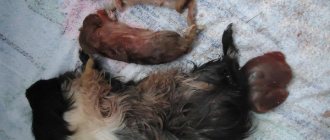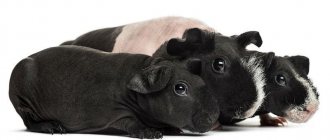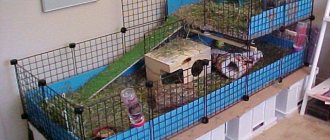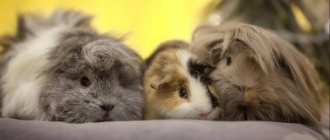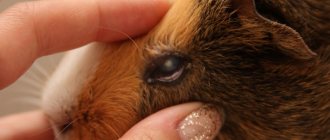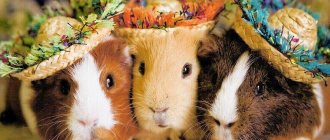A pregnant guinea pig is under severe stress because pregnancy is a complex process with many risks. The pet's appearance and behavior change. You need to be prepared for this and react correctly to changes, because the animal is completely dependent on the owner, whose duty is to provide the necessary help.
Guinea pig pregnancy
For all animals, pregnancy is a difficult period and this also applies to rodents. The owner should pay the most attention to the guinea pig at this stage.
It is worth taking into account that childbirth may be accompanied by deviations from the norm and the owner should also be prepared for this.
Pregnancy symptoms
It is difficult to determine pregnancy in a guinea pig in the early stages. There is a decrease in activity. And after about two weeks, clear signs begin to appear that the pig is expecting offspring:
- Belly growth. With the naked eye, you can notice an obviously rounded belly starting from the 3rd week of pregnancy. And at 7-8 weeks you will be able to see the activity of the babies, distinguishing their movements;
- Weight. The animal's appetite grows along with the development of the fruit; of course, the longer the period, the greater the weight. By the end of pregnancy, the female's weight may be twice as much as it was before;
- Appetite. Typically, appetite increases, but sometimes loss of appetite may occur. The animal may turn away from its favorite food. It is important to choose nutrition that promotes fruit development;
- Estrus. When a female guinea pig is pregnant, she is not in heat and the appearance of the genitals changes - swollen, loose and enlarged;
- Toilet. As the babies get bigger, there is pressure on the bladders and intestines, which increases the frequency of trips to the toilet.
Guinea pig puberty
It is believed that at 7-8 months a guinea pig is already capable of becoming pregnant and giving birth. Experienced owners do not recommend rushing to breed animals. At this age, the female is still in the process of formation, maturation, and an unstrengthened organism may not be able to withstand labor.
The safe age for mating is not only the achievement of puberty, but its establishment. In females it occurs at 11 months, in males a little later - at 12.
Mating is possible during the female's estrus period, which occurs every 2-2.5 weeks. Lasts about two days. The most productive period is the first 12 hours. The guinea pig shows its consent to mating in its behavior - being near the male, it spreads its hind legs and exposes its butt.
Possible problems
Despite the naturalness of this process, which should be inherent in any female animal, some complications may arise during and after childbirth:
- The youth of the female. Pigs can be used for breeding when they have reached a weight of 500 g. However, quite often females purchased from pet stores that live in the same cages with males may already be pregnant. However, if they are small, they are not able to give birth and raise offspring on their own.
- The female refuses to rupture the membranes of newborns. If this is not done in time, the babies may suffocate. The owner must help by tearing the film around the muzzle and clearing the mucus from the mouth and nose. To restore breathing, the baby is held tightly in the hand and shaken vigorously. They are then dried with a soft cloth and placed close to a heat source, such as a bottle of warm water. An hour later, when he can move, he is placed next to his mother.
- Termination of labor. If the uterine contractions have stopped, and there are still fetuses in the uterus, it is imperative to take the female to a veterinarian. He will help you surgically remove them.
- Refusal to breastfeed. This happens quite rarely, but nothing can be done. In this situation, children will need to be artificially fed.
- Shy female. Sometimes females can be frightened of their children, even though she has already partially licked them. She screams loudly and runs away, but since the babies are cold, they follow their mother, scaring her even more. If nothing is done, they will die from hypothermia. In this situation, you need to remove the babies, and after a while start adding them one at a time, giving the mother time to sniff them. If all else fails, then the owner needs to feed.
- Lack of milk. A young female may not have enough milk to produce a litter that is too large. In this case, you need to find another female or help the animal do this. The most suitable milk composition is pig milk. To obtain additional energy, honey and vitamin drops are added to it.
As you can see, caring for a pregnant guinea pig is not difficult, but it has its own nuances. Knowing them, you can carry out childbirth without problems and also provide the necessary care for the offspring and the female.
Pregnancy period
Length of pregnancy
Average time is about 10 weeks. The duration of this period can be affected by the animal’s age, breed, number of fetuses, as well as the health characteristics of a particular female. Of course, if there are two or more babies in the tummy, then the gestation period will be reduced to 58-62 days. When the baby is the only one – 70-75 days.
Number of cubs
If a guinea pig becomes a mother for the first time, it often means 1, maximum 2 babies. In case of repeated pregnancy, the probable number of children is 2-5.
Unlike hamsters, guinea pigs are born with their eyes open and fur. Which makes them somewhat independent from their mother.
Caring for your pig during pregnancy
The owner’s task is to create a comfortable, calm environment for the expectant mother, so that the pregnancy proceeds well and the birth occurs on time. Loud sounds and noise should be avoided, and you should also avoid picking up the pig often.
There is a set of simple but important recommendations:
- As soon as it becomes clear that the guinea pig is pregnant, you need to transplant it from the male and other neighbors into a separate cage. This is necessary for a calm environment, and to avoid re-mating immediately after childbirth.
- Leave only the essentials in the cage - a drinking bowl, a bowl of food, a house. Remove ladders, swings, etc., eliminating the risk of injury.
- The cage should be located in a place where there are no drafts, no sudden changes in temperature, no direct sunlight, as this can cause toxicosis in the animal, even death.
- Bathing should be avoided during pregnancy, so as not to further frighten the animal.
- Do not pull the female out of the cage unless necessary, but if necessary, this should be done carefully, with both hands, supporting the tummy.
- Skin care may be required as cracks may appear on the abdomen. It is enough to lubricate with baby cream. If the breed is long-haired, then at the beginning of pregnancy you should cut the hair so that it does not get dirty.
- It is recommended to replace the hay bedding with fresh hay daily and wash bowls and drinking bowls. The cleaning process should take place calmly, again, so as not to scare the animal.
- If the pet is not shy and shows interest, then short walks outside the cage are allowed to maintain activity and prevent possible obesity.
- You should only visit a veterinarian if there are any disturbances in behavior or well-being.
Diet of a pregnant animal
It is very important not only to increase the diet depending on the period, but also to make it complete and balanced. It is during pregnancy that pigs lack vitamin C and calcium, which are very important for future offspring. Monitor the availability of clean water in the drinking bowl.
In addition to the usual food, hay, fresh vegetables, herbs and fruits, the guinea pig's menu should include:
- Dairy products (cottage cheese, milk);
- Specialized food for pregnant pigs.
Refusal to eat after delivery is a signal that you urgently need to visit a veterinary clinic. The cause may be serious health problems.
Giving birth to a guinea pig
A thirsty guinea pig may indicate that labor is about to begin. Also, the expectant mother begins to worry and fuss, as if trying to find a suitable place.
The birth of guinea pigs
Often, piglets are born at night, when it is dark and quiet. They last about an hour, but the time may increase if there is more than one cub or this is the rodent’s first experience.
A guinea pig, already in the process of giving birth, seems to be sitting with its head lowered to the pelvis. During contractions, you can hear what sounds like hiccups, but this is an inherent sound of contractions. The female breaks the amniotic sac herself as soon as the babies are born, then licks and feeds them.
After completing the process, the owner should carefully replace the litter with clean one.
Assistance in childbirth
It happens that an animal needs human help. How you can help your pet during childbirth:
- Due to inexperience, the pig may not have time to do this and, without waiting for suffocation to occur, the owner must remove the film himself, wipe off the mucus with a clean napkin and return the child to the mother;
- If difficulties arise in the fetus exiting the birth canal, it should be carefully treated with Vaseline, then, moving clockwise, remove the baby;
- The contractions dragged on, there was bleeding, foam from the mouth - we need a veterinarian.
Guinea pig diet after birth
In order for a nursing mother to have enough milk, the diet must contain protein and calcium. In general, the list of products is similar to that during pregnancy. The pet still needs fresh vegetables, fruits, herbs, milk, cottage cheese. And the portion of ready-made food should be reduced. And, of course, fresh water, in sufficient quantities.
Offspring
Unlike other rodents, such as rats and hamsters, guinea pig babies are born with their eyes open, covered in fur, and with teeth erupting. Literally immediately after birth they begin to move independently.
Newborn guinea pigs
A good weight for a baby at birth ranges from 45-140 grams. If the weight is 40 grams or less, then there is a high probability of fetal death.
Also, the weight will depend on the number of cubs; the more babies, the less their weight. Accordingly, if the female has the first pregnancy, then the baby will be alone and his weight will be good.
Already in the first days, guinea pig babies begin to try food, repeating everything after their mother. The litter is transplanted into a separate cage about a month after birth.
Caring for piglets
It is not recommended to pick up babies in the first days after birth, but if this is necessary, you should thoroughly wash your hands before doing so.
To provide newborn pigs with optimal living conditions, it is enough to follow a few rules:
- If there are several babies in the litter, then several bowls and drinkers will be needed;
- The family's cage must be spacious. It is important that there are no gaps or large distances between the rods in order to prevent children from escaping or getting stuck;
- There is no need to rush to return previously removed ladders, hammocks, etc.;
- Just as during the female’s pregnancy, it is important that the cage is not exposed to sunlight and there is no draft. The room should be warm - 18-20 degrees;
- A couple of days after the birth of the pigs, you need to completely wash the cage. In the future, it is advisable to carry out disinfection several times a month;
- Of course, ensure peace and quiet, without sharp, loud sounds.
Brood diet
The mother pig feeds the babies with her milk for about a month; it is very nutritious and fatty. But, as already mentioned, copying their mother’s behavior, babies begin to try dry food and other solid foods early. In addition to food, you can include nuts and cereal flakes in your diet. What they do not have time to eat in a day should be removed, not including food, in order to avoid poisoning.
These animals are designed in such a way that it is normal for them to eat their mother’s feces. In them, the younger generation finds vitamin B and potassium, which are important for proper development and growth.
Selection of animals for breeding
When choosing a female and a male, first of all they pay attention to the health of both, so that the offspring are healthy.
It is important to avoid mating closely related individuals; such an experiment may be unsuccessful. There is a risk that the children will be weak and have health problems. The number of pregnancies in one female per year should not be more than two; the animal’s body needs time to recover. The health of the mother directly affects the health of the babies born.
It is better to choose guinea pigs of the same breed if there is no goal of mixed breeds. Basically, breeders prefer to maintain the quality of the offspring without crossing different representatives.
Baby care
After the guinea pig has given birth, there is nothing special for a person to do, since the mother herself is capable of caring for the offspring. Usually 1 to 5 cubs are born. Their weight is about 50-100 g (it all depends on the size of the litter), they are covered with hairs, have teeth, their eyes are open and in just a few minutes they can move independently.
The female has only two nipples, but they are quite enough to feed all the offspring - the newborns suckle in turns. From the third day, babies begin to try food for adult animals.
If for some reason the pig refuses to feed the babies or she does not have milk, the cubs are transferred to artificial feeding or placed with another mother. Before this, the piglet’s fur is wiped with sawdust taken from the stepmother’s cage so that the latter can better accept the foundling.
You can also raise offspring using artificial feeding. To do this, newborns are administered 1 cc using a pipette. see baby formula every two hours for a week. They are also given hay and green food.
Do not forget to stimulate defecation and urination in orphans using a cotton pad, which is used to irritate the anal area.
Signs of pregnancy in guinea pigs
The first thing you notice when a guinea pig is pregnant is a change in its usual behavior. A pregnant animal becomes less mobile and tries to hide in its house or in the corner of its cage.
It is also possible to show aggression towards their relatives and, especially, towards the male. In addition, there are a number of other signs, such as:
- Changes in your guinea pig's appetite. As a rule, during pregnancy, the female's appetite increases, and accordingly, she requires more food. But sometimes it happens the other way around - a guinea pig may refuse its favorite food completely or go through the food.
- Stomach. One of the obvious signs of pregnancy is an enlarged abdomen in the animal. The growth of fetuses in guinea pigs occurs quite quickly, and a strong increase can be noticed already from the third week. After seven weeks of pregnancy, you can see the movement of the fetuses in the abdomen of the animal.
- Weight. It follows from the previous sign. During pregnancy, the pig gains weight due to increased food intake and fetal growth. A noticeable weight gain during pregnancy can be observed as early as the fourth week. As birth approaches, the animal's weight may double its original weight.
- Estrus. Typically, estrus occurs once every two weeks. During estrus, the guinea pig arches its back and makes a characteristic rumbling sound when stroked. The approximate duration of estrus is about a day, during which time the animal’s vagina is swollen and moist. During pregnancy, there is no estrus, and changes in the external genitalia also occur: they become loose, swell, which is why their size increases.
- Toilet. Due to the growth of the fetus, the uterus begins to compress the animal’s intestines and bladder, resulting in an increase in the number of acts of defecation and urination.
Behavior change
If you know your pet well and have often observed it, then you will notice changes in behavior immediately. The female moves less, one might say that she becomes lazy.
She tries to build herself a separate house, looks for a secluded corner and buries herself in the hay. Refusal of any treats may also occur. Can show aggression towards the male sex.
Guinea pig gestation period and offspring
The timing of gestation and birth varies depending on the breed, age of the guinea pig and the number of pups it is carrying.
Typically, the pregnancy and birth process for a guinea pig takes about 10 weeks. If the expectant mother is carrying 1-2 babies, the duration of pregnancy is 70–75 days, and in case of multiple pregnancy the period is reduced to 58–62 days.
If a guinea pig gives birth for the first time, then there will be 1-2 newborn animals in the litter; females who have already given birth can bear 2-5 cubs.
Newborn guinea pigs are already covered with fur. They are born with open eyes and teeth erupting. Immediately after their birth, they are ready for independent life.
Puberty
Early pregnancy in guinea pigs can end unsuccessfully. The reason is that the mother’s body is not fully strengthened and is not ready for childbirth. Premature mating often leads to illness, pathology and weak or stillborn cubs. It is not uncommon for a guinea pig to die during childbirth.
Males mature at 2-2.5 months. At this point, both he and the female should weigh 500-700 g.
Breeders often have a question: at what age can a guinea pig become pregnant? Females are ready to breed from 7-9 weeks. The individual is fully ready for mating at 11-12 months. Living together in the same cage with a male guarantees the birth of piglets all year round. A male is capable of covering no more than a dozen females.
A favorable time for conception is considered to be estrus, which lasts 1-2 days. The pet is brought together with a partner 10-12 hours after the start of the hunt. The break between estrus is from 14 to 18 days.
How to care for a guinea pig during pregnancy?
Like any living creature, a pregnant guinea pig requires special care during pregnancy and childbirth. First of all, it is not recommended to frequently pick up the animal; it is also necessary to protect it from any stressful situations, such as loud noise, screams and moving the home, in order to avoid possible miscarriage or premature birth.
There are a number of tips that must be followed to ensure maximum comfort for your guinea pig during pregnancy:
- Throughout pregnancy, the pig must be isolated from the male for several months to avoid premature birth and mating of the female immediately after the birth of the offspring. It must be kept in a cage separate from its relatives, which will not be exposed to direct sunlight and will not be exposed to drafts.
- It is necessary to remove all traumatic objects, such as hammocks, shelves, ladders, etc., in order to eliminate situations that are dangerous for newborn cubs.
- In the room where the cage with the pregnant female is located, it is necessary to maintain a constant temperature and humidity. Severe changes in humidity, sudden increases and decreases in temperature should be avoided - this can lead to early birth or the development of toxicosis, which can lead to the death of the animal.
- It is necessary to take a guinea pig for inspection and weighing with extreme caution so as not to frighten the animal. By frightening a rodent, you can provoke a miscarriage or the occurrence of traumatic situations. You need to remove the pig from the cage by holding it by the abdomen, without sudden movements or noise. It is also necessary to exclude frequent bathing of the female.
- You need to closely monitor the health of your guinea pig. During pregnancy, the volume of the animal's abdomen increases significantly, which can cause cracks in the skin. To prevent this, we recommend lubricating the skin on the guinea pig’s abdomen with baby cream. Females of long-haired breeds are recommended to be clipped in the early stages of pregnancy to reduce coat contamination.
- Regular cleaning of the cage and daily change of hay bedding are necessary. When cleaning, do not make sudden movements or make noise - this exposes the animal to stress. A few days before giving birth, it is recommended to remove the guinea pig’s usual home from the cage and install a nesting house.
- To prevent obesity and congestion from developing in the body of a pregnant guinea pig, it is recommended that the female take a short walk outside the cage 1-2 times a day, but only if the animal’s pregnancy proceeds without complications or stressful situations.
- Observation in a veterinary clinic during late pregnancy and x-ray examination are allowed only if pathological processes of pregnancy arise or doubts about the health of the animal. If the female is too shy, it is recommended not to subject her to any examinations to avoid stressful situations.
Weight gain
Of course, your beloved pet will gain weight; by the time she gives birth, the female will double her weight. It is recommended to regularly weigh the expectant mother and record her weight to monitor her normal condition.
When weighing, you need to be as careful as possible so as not to harm either the pet or the fetus; carry them very carefully.
Features of feeding a guinea pig during pregnancy
When caring for a guinea pig during pregnancy, it is necessary to pay sufficient attention to the feeding process. Carefully monitor the cleanliness of feeders and drinkers (it is recommended to wash them at least twice a week), as well as the amount of food.
During pregnancy, it is necessary to increase the amount of food for the animal by two times, and by the end of pregnancy - three times.
For feeding, you should use both classic versions of food for rodents, hay, and:
- fresh vegetables and herbs;
- special granulated food for pregnant rodents;
- milk;
- cottage cheese.
After the birth of the cubs, the female experiences thirst for some time, so it is necessary to ensure that there is always fresh water in the drinking bowl. It will also be useful to give the animal juicy fruits.
If a guinea pig refuses to eat after giving birth, it is necessary to show the animal to a veterinarian. Possible causes of lack of appetite include the development of endometritis, which can lead to the death of the animal.
Selection of animals for breeding
To get strong, healthier offspring, you need to wisely select a pair for your rodent. Only clinically healthy animals are allowed for breeding. Guinea pigs must meet the following parameters:
- be active, mobile;
- have beautiful shiny fur, clear eyes;
- be moderately well-fed;
- have excellent breed qualities.
Animals suffering from obesity, chronic, congenital pathologies, defects, exhausted, sick rodents are not suitable for breeding. The weight of the female before mating should not be less than 700 grams. The expectant mother must be absolutely healthy and in excellent physical shape.
It is also not recommended to mate females who have not given birth and are older than one year, since the ligaments lose elasticity and the birth of a guinea pig can end in failure.
In order for the offspring to be born strong, healthy, and viable, female guinea pigs should not give birth more than twice a year. Males can be bred 2–4 times a year. In case of uncontrolled use of males, females will remain uncovered.
The best period for breeding guinea pigs is mid-spring and early summer. At this time there is a lot of varied and healthy food for rodents.
A week before the planned mating, you need to supplement the rodents’ diet with food that is rich in proteins, essential amino acids, vitamins A, E, C. Feed the pig sprouted wheat and high-quality cereals. Supplement your diet with succulent food, herbs, vegetables, and fresh hay.
